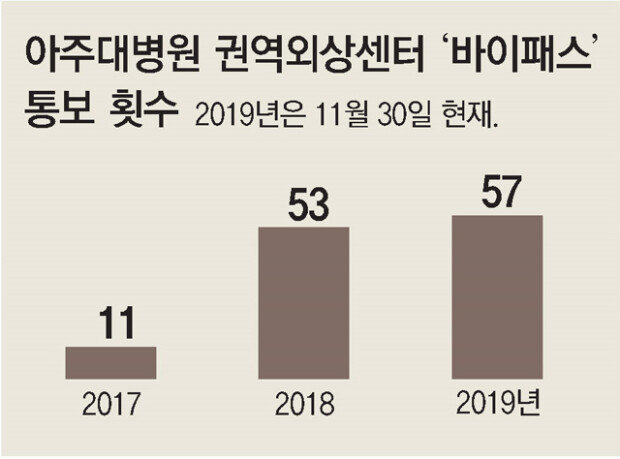Dr. Lee Guk-jong’s trauma center was closed for 34 days this year
Dr. Lee Guk-jong’s trauma center was closed for 34 days this year
Posted December. 06, 2019 07:42,
Updated December. 06, 2019 07:52

The phone in the night-duty room of Ajou University Hospital's trauma center in Suwon, Gyeonggi Province rang every five minutes or so. The nurse who picked up the phone repeated the same answer, “We apologize but we are not able to take more patients as there is no empty bed.” The trauma center sent “bypass” notification to the National Fire Agency to prevent additional patients from being sent to the center as its 100 beds to treat severe traumatic injuries have been all full. This was the situation of South Korea’s largest regional trauma center with the highest number of personnel at 3 p.m. on November 27.
The trauma center led by Professor Lee Guk-jong at Ajou University Hospital is the medical institution with the final responsibility to take care of patients with severe traumatic injuries in the southern region of Gyeonggi Province, including 21 cities and counties, such as Gwacheon, Seongnam, and Bucheon. The regional trauma center is the last bastion to keep the “golden time” for patients while nearby emergency rooms send patients away due to limited human resources and equipment.
However, the trauma center sent the “bypass” notification on 57 occasions and was unable to receive patients from the beginning of this year to November 30. All in all, the center was closed for 34 days 2 hours and 57 minutes, including the time under bypass. The regional trauma center responsible for 9.7 million populations in the south of Gyeonggi Province had its door closed for over one month. “It’s a bit embarrassing to call our center as a regional trauma center at this point,” said those who work in the center. The number of bypass notifications sent by the center reached 53 times in 2018 from 11 times in 2017, and the situation has gotten even worse in a year.
The regional trauma center used to borrow beds from other departments to receive more patients, but such borrowing has reached its limit now. As other departments complain about the lack of beds needed for patients, the hospital has banned such practice. In addition, some parts of the hospital are going through remodeling, which has aggravated the situation. “It’s quite unfortunate as the Ministry of Health and Welfare pledged to spare no support in terms of facilities and human resources in 2013 when the hospital submitted a business plan to maintain the regional trauma center to the ministry,” lamented a source of the center.
The current situation has created a vicious cycle. A patient with severe traumatic injuries is first admitted to a different emergency room instead as the trauma center doesn’t have a bed available. Once a bed becomes available after waiting for dozens of hours, the patient is finally able to receive specialized trauma treatment. However, the prognosis is not great as proper care was not provided in the early stage. The patient needs to be hospitalized in the regional trauma center for a longer period of time to recover.
Ajou University Hospital's trauma center has the most beds among 14 regional trauma centers in the country. The Ministry of Health and Welfare does not have enough understanding of the situations in other centers. When the emergency care garnered a lot of attention with the sudden death of Yoon Han-duk, head of the Central Emergency Medical Center, in February, the government promised to put forward necessary measures and provide support by creating several consultative groups. Late surgeon Yoon, however, will only find the situation at hand deplorable.
조건희 기자 becom@donga.com





![넘치는 전재수 과거 사진들…유죄의 증거일까, 무죄의 증거일까[청계천 옆 사진관]](https://dimg.donga.com/c/138/175/90/1/wps/NEWS/IMAGE/2025/12/20/132997378.1.jpg)

